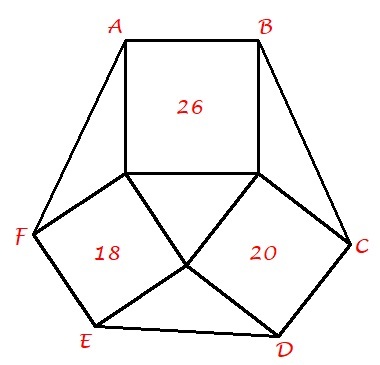Squares and triangles to hexagon

The areas of the three squares in the figure below are given inside corresponding squares.
Find the area of hexagon to the nearest integer.
This section requires Javascript.
You are seeing this because something didn't load right. We suggest you, (a) try
refreshing the page, (b) enabling javascript if it is disabled on your browser and,
finally, (c)
loading the
non-javascript version of this page
. We're sorry about the hassle.
Relevant wiki: General Polygons - Area
( 2 6 ) 2 = ( 1 8 ) 2 + ( 2 0 ) 2 − 2 ( 1 8 ) ( 2 0 ) ( cos β ) ⟹ β = 7 1 . 5 7
( 2 0 ) 2 = ( 1 8 ) 2 + ( 2 6 ) 2 − 2 ( 1 8 ) ( 2 6 ) ( cos θ ) ⟹ θ = 5 6 . 3 1
( 1 8 ) 2 = ( 2 6 ) 2 + ( 2 0 ) 2 − 2 ( 2 6 ) ( 2 0 ) ( cos α ) ⟹ α = 5 2 . 1 3
∠ A G F = 1 8 0 − 5 6 . 3 1 = 1 2 3 . 6 9 ; ∠ B H C = 1 8 0 − 5 2 . 1 3 = 1 2 7 . 8 7
∠ E I D = 1 8 0 − 7 1 . 5 7 = 1 0 8 . 4 3
In computing the area of each triangle, we use the formula: A = 2 a b sin C
A G H I = 2 1 ( 2 6 ) ( 1 8 ) ( sin 5 6 . 3 1 ) = 9
A A G F = 2 1 ( 2 6 ) ( 1 8 ) ( sin 1 2 3 . 6 9 ) = 9
A E I D = 2 1 ( 1 8 ) ( 2 0 ) ( sin 1 0 8 . 4 3 ) = 9
A B H C = 2 1 ( 2 6 ) ( 2 0 ) ( sin 1 2 7 . 8 7 ) = 9
A A B C D E F = 2 6 + 1 8 + 2 0 + 4 ( 9 ) = 1 0 0